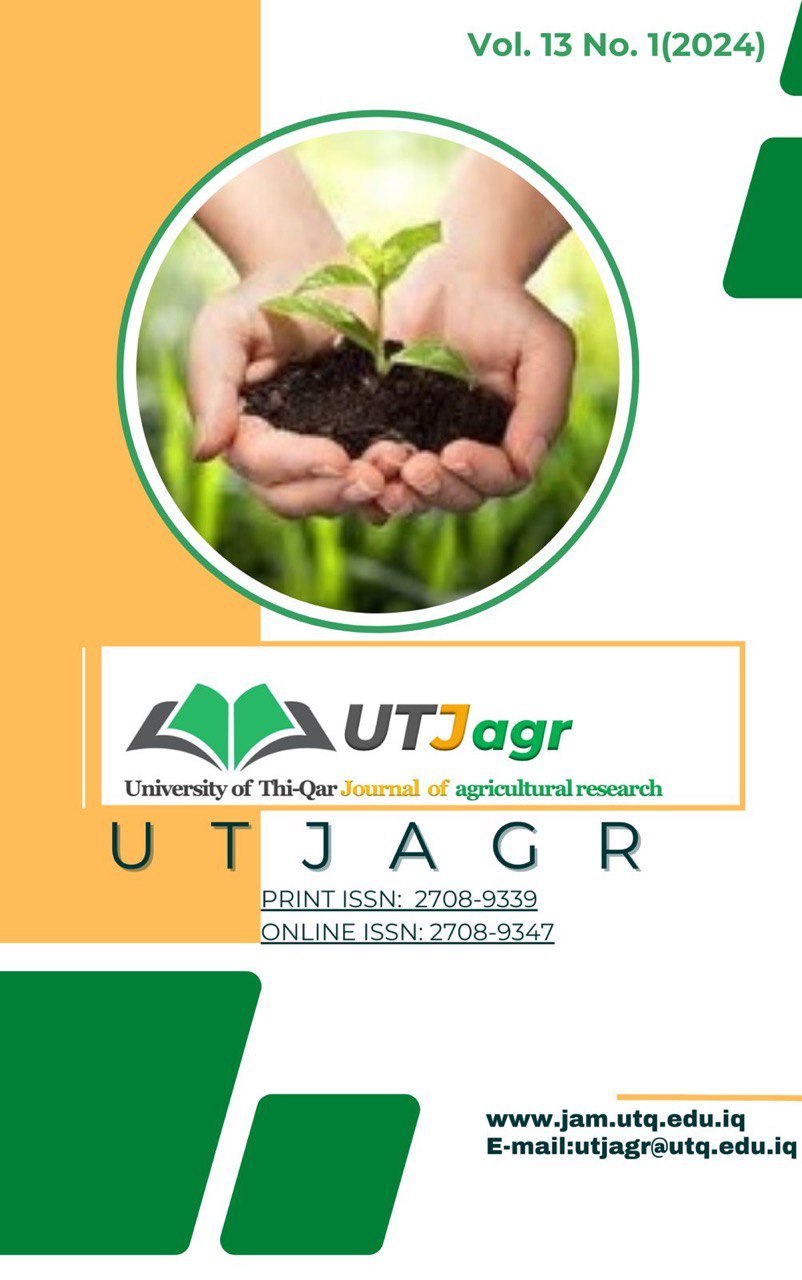A Study of Phenotypic Characteristics of Eggplant Grown via the Sandponic Technique
DOI:
https://doi.org/10.54174/utjagr.v13i1.307Keywords:
Sandponic, EggplantAbstract
Abstract
Sandponic is a developed technology working for the prosperity of food security. It means growing plants and fish together in a recycling environmental system which uses natural bacterial cycles to use fish waste as plant nutrition. Eggplant is regarded as the most important Solanaceae crops because their nutritional benefits. This plant is a major crop in both temperate and tropical regions in this world. Eggplant – French Flomorin varity- was planted in sandponic boards and natural ground. Five plants were selected randomly from each experimental unit in the green-growth phase and the indicators of the green-growth were recorded. The results showed that there are significant differences in the height of the plant regarding the water quality, temporal period and the interaction between them. The quality of water without fish recorded the highest mean of plant height, whereas the period 140 days after growing recorded the highest mean of the plant length in comparison with the period 70 days from the growing time. In addition, the study results indicated significant differences in the number of the plant leaves for each the water quality, temporal period and the interaction between them. That is, the number of leaves in plants irrigated with water without fish was the highest in comparison with the number of leaves of the plants irrigated with fish water. Concerning the temporal period, the period of 140 days from the growing recorded the highest mean of leaves number in comparison with the period of 70 days since the time of growing. Regarding flowers number, the results showed significant differences in the mean of water quality and no significant differences in the temporal period and the interaction between them. The results recorded the highest number of flowers after 70 days from growing in comparison with their number after 140 days from growing. Also, it appeared that the highest number of flowers in plants irrigated with water without fish compared with those irrigated with water having fish. The results showed that there were significant differences between water quality, temporal period and interaction between them concerning the plant height and leaves number. Regarding to the number of flowers, the study results indicated that there significant differences of water quality only, whereas -in regard to temporal period and interaction between them, no significant differences were shown by the results.
Downloads
References
References
- Al-Saadi, Firas Muhammad Jawad. Complete crossbreeding of four genotypes of local eggplant. Master's thesis, College of Agriculture, University of Baghdad, Iraq .2001.
- Aied KY, Wahab Z, Kamaruddin RH, Shaari AR. Growth response of eggplant (Solanum melongena L.) to shading and cultivation inside greenhouse in a tropical region. Int. J. Sci. Eng. Res. 2017;8(5):89-101.
- Mahanta CL, Kalita D. Eggplant. InNutritional Composition and Antioxidant Properties of Fruits and Vegetables 2020 Jan 1 (pp. 273-287). Academic Press.
- Alam I, Salimullah M. Genetic engineering of eggplant (Solanum melongena L.): Progress, controversy and potential. Horticulturae. 2021 Apr 11;7(4):78.
- Hamid and Saqb, Wissam Ali, Anwar Mohsen. Estimating losses and water needs in Iraqi agriculture for the 2018 agricultural season, Al-Kout Journal of Management Sciences and Economics, Volume 12, Issue 38, 2020.
- El-Nemr MA, El-Baky MM, Salman SR, El-Tohamy WA. Effect of different potassium levels on the growth, yield and quality of tomato grown in sand-ponic culture. Australian Journal of Basic and Applied Sciences. 2012;6(3):779-84.
- Torarinsdottir, R. I. Aquaponics Guidelines. University of Iceland. 2015.https://skemman.is/bitstream/1946/23343/1/Guidelines_Aquaponics_20151112. pdf. DOI:10.13140/RG.2.1.4975.6880.
- Makokha P, Ssali RT, Rajendran S, Wanjala BW, Matasyoh LG, Kiplagat OK, McEwan MA, Low JW. Comparative analysis for producing sweetpotato pre-basic seed using sandponics and conventional systems. Journal of Crop Improvement. 2020 Jan 2;34(1):84-102.
- Haghshenas A, Emam Y. Accelerating leaf area measurement using a volumetric approach. Plant Methods. 2022 May 9;18(1):61.
- Liu S, Jin X, Nie C, Wang S, Yu X, Cheng M, Shao M, Wang Z, Tuohuti N, Bai Y, Liu Y. Estimating leaf area index using unmanned aerial vehicle data: shallow vs. deep machine learning algorithms. Plant Physiology. 2021 Nov 1;187(3):1551-76.
- Kowalska G. Flowering biology of eggplant and procedures intensifying fruit set–review. Acta Scientiarum Polonorum Hortorum Cultus. 2008 Dec 31;7(4):63-76.
- Kowalska G. Eggplant (Solanum melongena L.) flowering and fruiting dynamics depending on pistil type as well as way of pollination and flower harmonization. Folia horticulturae. 2006;18(1):17-29.
- Çekin, D., El-Gabry, H., Lothmann, R., Hassan, N., Hassanen, M., Hassanen, M., & Sewilam, H. (2023). Assessing different hydroponic subsystems for Batavia lettuce growth under different planting density treatments.
- Sapkota, S., Sapkota, S., & Liu, Z. (2019). Effects of nutrient composition and lettuce cultivar on crop production in hydroponic culture. Horticulturae, 5(4), 72.
- Khalil, Mahmoud Abdel Aziz Ibrahim. Physiology of vegetable plants. 1st edition, Alexandria: Mansha’at Al Maaref. 2013.

Downloads
Published
Issue
Section
License
Copyright (c) 2024 Abbas Al Tamimi

This work is licensed under a Creative Commons Attribution-NonCommercial-ShareAlike 4.0 International License.







1.png)

